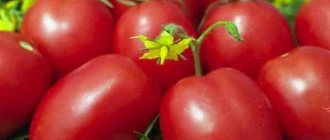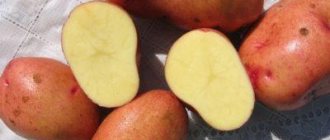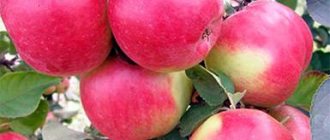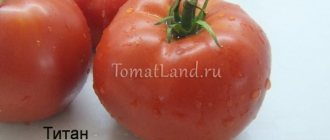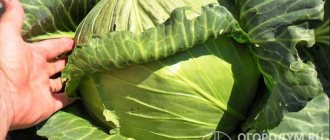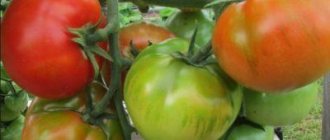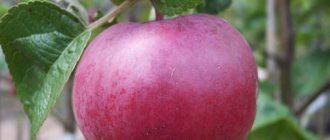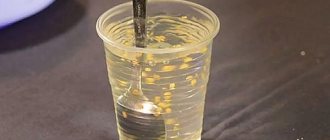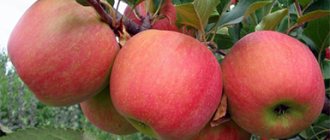This name has long been known to gardeners and often awakens warm memories of a tasty, productive and famous variety of apples . Now it is somewhat crowded out by overseas novelties, but this does not detract from its qualities and advantages.
This variety combines many wonderful qualities and undeniable advantages. The fruits have excellent taste, good yield and frost resistance. The variety is reliable, time-tested.
This explains such great sympathy and love among gardeners for him.
Description
This variety was bred in 1928 at the Mlievskaya horticultural station named after. Semirenko L.P. in Ukraine. Another name is Glory to the survivors .
Papirovka and McIntosh were crossed And since 1954, it was zoned throughout the former Union.
This is a very popular autumn ripening variety:
- Its fruiting is stable,
- High yield,
- Good winter hardiness
- Resistance against diseases: powdery mildew and scab - average.
This apple tree is a tall one, the crown is pyramidal .
The bark of the main branches is brown.
The leaves are light green in color and rounded.
The flowers are pink, saucer-shaped, red buds.
Smooth-skinned
fruits The color of ripened fruits is light green with a red blush. The flesh of the fruit is light, slightly creamy. Apples are juicy, aromatic, sweet and sour taste. Important! Depending on the region, fruit ripening occurs from early August to early September.
Advantages and disadvantages
The “Glory to the Winners” apple tree was highly appreciated for the dessert taste and beauty of the fruit not only by consumers, but also by specialist breeders in Ukraine, the North Caucasus and other regions of the former Union, who created many new varieties on its basis.
Amateur gardeners highlight other strengths of “Slava”:
- relatively high winter and frost resistance;
- relative resistance to scab;
- high yield with not clearly defined frequency of fruiting.
The disadvantages of the variety include:
- average drought resistance;
- tendency to intensive shedding of ripened fruits, low indicators of their keeping quality and transportability;
- self-sterility.
High productivity allows you to harvest about 80 kilograms of apples per season from one mature tree
Additional characteristic
origin of name
Apples of the Glory to the Winners variety ripen when earlier apples have already completed fruiting, and autumn apples are still filling. During this period, luscious handsome men appear in all their glory and enter the arena as winners . And Glory to the Winners!
Peculiarities
- The tree looks very impressive during the flowering period and blooms profusely.
- The flowers emit a delicate aroma.
- Apples are very juicy when ripe.
- This apple tree is classified as a reliable variety and produces stable and rich harvests.
Interesting! A distinctive feature of the variety is that when ripened, the seeds do not fuse with the seed chamber, remain free and rattle when shaken.
Apples Glory to the Winner.
Winter hardiness
The Pobeditel apple tree variety has good winter hardiness .
For this reason, they can be grown both in more northern areas and in southern ones. At the same time, the timing of fruit ripening will change accordingly.
Tree height, crown width
The Slava apple tree is a vigorous tree .
Its crown is broadly pyramidal. Over the years, the shape of the crown changes. Becomes highly rounded or highly oval.
The branches are located at sharp angles to the trunk, rising upward. But then the location of the branches changes, they grow to the sides.
Bark color
The main branches of the apple tree have brown bark, and the shoots are straight in shape.
Young shoots have a reddish-brown color, they are shiny, slightly elbowed.
The leaves are medium in size, round in shape, pointed at the ends, and light green in color.
They have a slightly noticeable yellowness, slight pubescence, slightly colored petioles and small stipules.
Features of reproduction
The apple tree Glory to the Winners is self-sterile. Such apple trees are unable to self-pollinate . Many varieties of apple trees are like this.
The yield of these fruit trees depends on the pollination of pistillate flowers of one variety with pollen from another variety.
For such pollination , it is desirable that suitable trees grow at a distance of no more than fifty meters . For example, these could be apple trees from a neighboring summer cottage.
These features of the variety must be taken into account when planting an apple orchard . Apple trees are selected in such a way that they have the same time of entering the fruiting season.
Beginning of fruiting
The timing of the onset of fruiting depends on the area of growth . They are considered medium-term fertile.
To the south, these trees begin to bear fruit 4-5 years after planting.
In the far south, these periods can be reduced to two years.
But in the northern regions, fruiting occurs noticeably later.
In the first years, apple trees produce a good harvest every year, but then - with a certain frequency.
Their fruitfulness is above average . The number of apples harvested from one hectare of garden area is 110-200 centners.
Important! Despite its good yield and frost resistance, the Slava to the Winners variety has low drought resistance.
Scab resistance
average resistance to this fungal disease
- Leaves affected by this disease become covered with dark spots, curl, dry out, and then fall off.
- Fruits may also become stained and deformed.
It is necessary to monitor the condition of the leaves and fruits of the tree, and promptly treat with chemicals to prevent the occurrence of this disease.
Tasting assessment
Glory to the Winners apples have an excellent taste .
The pulp is tender, juicy, aromatic. Its color is white-yellowish or light cream, its taste is sweet and sour . According to the tasting scale (five-point system), they are 4.4-4.6 points.
Fruit of the apple tree Glory to the Winners.
The fruit contains sugars, vitamins - C, B, E, P-active substances, minerals.
Advice! Apple fruits are consumed fresh. They make excellent jams, preserves, and delicious juices; they are used for drying and soaking.
Consumer qualities of fruits
Apples are large (at optimal air humidity and on well-moistened soils) and medium-sized: weighing about 125 g, maximum up to 180 g. The shape is round, oblong-round or slightly narrowed (cone-shaped) in the upper part. The surface is smooth or with barely noticeable ribbing. The skin is smooth, covered with a light waxy coating, with numerous light subcutaneous spots, the centers of which are often suberized.
When fully ripe, apples, covered with a uniform bright red blush, do not hold well on the tree.
When picked, the color of the fruit is light greenish with a continuous blurred red blush over the entire surface. The pulp is white-cream, sometimes with a pink tint, tender, medium-grained, juicy, aromatic, with an excellent sweet and sour taste. Professional tasting scores – 4.2-4.6 points (out of 5). Numerous reviews describe the taste as “amazing”, sweet with a pleasant sourness and honey aroma.
According to the results of biochemical studies conducted by VNIISKP specialists, the fruits of this variety contain:
| Nutrients and beneficial substances | Quantity (per 100 g raw product) |
| Vitamin C (ascorbic acid) | 8 mg |
| Total sugars | 13-14.4 g |
| Acids | 0.8 g |
| P-active substances | 110 mg |
Apples of the “Glory to the Winner” variety are for table use, excellent for fresh consumption and various processing methods.
The timing of ripening and storage directly depends on the climatic characteristics of the region of cultivation: in the Kuban, fruits reach technical ripeness in the first half of August, and in the central regions, for example Oryol, in early September. “Southern” fruits are stored for only 2 weeks, and more “northern” ones - about 1.5 months , but if picked in a timely manner and properly stored, they can last until December. Apples do not tolerate long-term transportation well, since the juicy pulp and delicate skin are quickly damaged. Therefore, the variety is grown mainly for personal use and quick processing.
Reviews
Irina: I purchased this apple tree when I was two years old, after seeing a description, photo, and reviews. And we collected the first harvest in the third year after planting . The apples are wonderfully ripe and juicy. When the apple tree blossomed, the weather was not very warm, and the bees did not fly much. And we, taking apple flowers from a neighboring plot, tried to pollinate our apple tree by hand. Happened! But what I liked most of all was that the pests did not touch our Slava, although the neighboring one was damaged, many of the fruits were wormy.
Daria: In our family, everyone really loves the fruits of the apple tree. Glory to the Winners. Most are eaten fresh. I bake pies and strudels with apples.
Andrey Starkov: I do pruning in the garden and try to keep the branches of my apple and pear trees in order. The Glory to the Winner apple tree has to be looked after. Mandatory pruning and spraying against scab. This apple tree is very good. The fruits are tasty and aromatic.
Olga Ivanovna: It’s interesting to read about the care of Slava Peremozhtsev. It has been growing here for a long time, a good old variety, purchased after my parents read the photo and description of the variety. Fruiting is good, tasty apples. We love our beauty. Now we know that it is important to prevent the crown of the apple tree from thickening and spray it against pests.
Preparing the soil and planting site
Apple tree Glory to the Winners, description, photos, reviews is defined as a plant that requires an abundance of sunlight. The commercial qualities of apples, as well as their sweetness, strongly depend on the uniform illumination of the crown.
For planting seedlings, choose the most sunny place. The site should not be flooded by spring floods.
Selection criteria and features of planting the Glory to the Winners variety:
- When groundwater occurs closer than 3 m from the surface, a good drainage layer is provided in the planting pits. Tall specimens in such places are planted on bulk hills.
- The best conditions for the development of apple trees are provided by loam or sandy loam soils. The area should be dug up completely, ensuring the necessary aeration of the substrate.
- A suitable soil acidity level starts at 5 and should not exceed 7.5 pH. Otherwise, the soil needs to be limed.
On heavy soils, humus and peat are added for digging; on dense chernozems add sand and rotted sawdust. Sandy soils are fertilized with well-rotted compost or manure. The area is marked, leaving a distance between medium-sized Glory to the Winners apple trees of at least 3 m.
Preparation of planting pits for apple tree seedlings:
- dig holes about 1 meter deep and 70x70 in size;
- drainage is poured onto the bottom: pebbles, expanded clay, broken brick, crushed stone;
- a fertile layer is placed on top of several buckets of humus and compost mixed with fertile garden soil;
- Up to 1 kg of complex fertilizers and about 1 kg of wood ash can be mixed into the soil for the planting pit.
After laying the hole for the Glory to the Winners apple tree, it is spilled generously with water and left for the soil to shrink.
Landing
Apple trees are planted in autumn or spring, depending on the region and weather conditions:
- In a pre-prepared hole (diameter 70 cm, depth 1 m).
- The seedling is placed in a hole so as not to deepen the root collar too deeply.
- The roots are straightened with your hands.
- Holding the tree trunk vertically, cover it with prepared soil.
- The earth is carefully compacted.
- Then abundant watering is done (1 bucket).
- The tree is tied to a peg.
History of the variety's creation
The apple tree of this variety was obtained as a result of the hybridization of two varieties - the local ancient Papirovka apple tree and the American McIntosh apple tree. Work to obtain a new variety was carried out 90 years ago by breeders from the Mlievsky Experimental Horticulture Station named after L.P. Simirenko L.M. Ro and P.E. Tsekhmistrenko.
As a result, a new apple tree variety was obtained: Slava Pobeditelem, or in Ukrainian – Slava Peremozhtsy. This name was included in the State Register of Selection Achievements only in 1975. The breeder-originators of the variety recommended growing this fruit tree on an industrial scale in the following regions:
North Caucasus, Lower Volga, Central Black Earth.
Photo of apple tree Glory to the Winners
It was in these areas that apple trees of the Slava to the Winners variety were noted for increased productivity, stable regular fruiting, resistance to a number of diseases and other positive qualities of the trees.
However, later this fruit tree began to be successfully grown in the Central regions of Russia.
Care
Pollinator varieties
For the Slava Pobediteley apple tree, the best varieties for pollination are:
- Melba,
- Vadimovka,
- Priam,
- James Grieve
- Delicia,
- Antonovka is ordinary,
- Borovinka.
Pruning and crown formation
The crown of these apple trees is characterized by strong branching , so it is necessary to monitor its condition.
Avoid thickening, thin out.
It is necessary to try to cut out non-fruit-bearing branches , because... Such apple trees bear fruit on fruit twigs, ringlets, and spears.
Important! It is advisable to preserve this part of the crown.
Top dressing
Feeding begins in April - nitrogen-containing mixtures are applied (root feeding only):
- Urea,
- Ammonium nitrate and nitrophoska,
- Humus.
Next - during flowering:
- Substances that activate vegetation: superphosphate,
- potassium sulfate,
- chicken droppings,
- urea.
The next stage is feeding the apple trees after flowering (fruit filling phase): nitrophoska, green fertilizer.
In summer: in July - phosphorus and potassium fertilizers. For the winter - fertilizing with phosphorus-potassium fertilizers.
Chemical treatment
The apple tree can be affected by the following diseases:
- powdery mildew,
- Scab,
- Cytosporosis,
- fruit rot,
- Milky shine.
Spraying trees with copper sulfate.
To combat these diseases, drugs are used:
- Copper oxychloride,
- Topaz,
- Hom and other drugs.
Table: disease and pest control Glory to the winners
| Disease/pest | Description | Ways to fight |
| Powdery mildew | The leaves on the tops of the shoots are covered with a white coating, similar to flour. Then they dry out and fall off, and the fruits are also affected. Yields may be reduced by 40–60%. Young shoots do not ripen, buds do not form, and freeze in winter. | Before buds open, before and after flowering, and after harvesting, treat with the following preparations: 1% Bordeaux mixture, Topaz (2 ml per 10 l of water), Skor (2 ml per 10 l), HOM (40 g per 10 l) and etc. |
| Scab | All parts of the tree are affected, even the bark. But infection begins from the leaves. They become covered with olive spots, crack and dry out. Also, fruits, shoots and bark on the trunk become covered with spots and then cracks. Fungi of other diseases settle in damaged tissues, so scab is often accompanied by gray or fruit rot. | |
| Apple codling moth | The gray-brown moth has a wingspan of up to 2 cm. It begins laying eggs a week after the apple tree blooms, first on the leaves, then on the fruits. The born larvae (light worms with a dark head) climb inside the ovaries. During the season, one larva damages 2-3 apples. |
|
Photo gallery: main diseases and pests of the variety
White coating on the leaves is the first sign of powdery mildew
Signs of scab: olive spots on leaves, cracking cankers on fruits
Apples damaged by scab usually develop gray rot.
The codling moth is a nocturnal moth that looks like a large moth.
The codling moth larva damages 2–3 apples per season
Features of ripening and fruiting
What year does the harvest begin to bear?
The beginning of fruiting of apple trees (on weak vegetative rootstocks) in the southern territories is 4-5 years, in the northern territories - later.
Type of fruiting
In the first years, apple tree fruiting is regular, later – periodic. It depends on the condition of the soil.
Fruit ripening and storage times
The ripening time of these apples ranges from the first half of August to the second half of September, depending on the region, from south to north, respectively.
The shelf life of fruits in the southern part (Kuban) is two weeks; in the Oryol region (middle zone) they will be stored until December.
Productivity
A young tree can produce a harvest of up to 10-20 kg of apples per tree. Growing up, the tree already produces about 70 kg, in the South - on average 190-200 kg per hectare. The maximum yield is known - 300 kg per hectare.
Harvesting and processing
The assignment of Glory to the winners is universal. Apples can be picked unripe and ripened indoors. They tolerate transportation well and are stored in the cellar or refrigerator until the New Year, that is, 3-4 months. The variety is suitable for industrial cultivation and processing of fruits into dried fruits, jam, juices, as well as for cultivation in private gardens. Apples are good in fresh form and in preparations: compotes, jams, you can use them to make homemade marmalade and drinks, including alcoholic ones (cider, brandy).
Video: homemade cider recipe
Varieties of rootstocks
The variety Glory to the Winner can be grafted onto dwarf, semi-dwarf and medium-sized rootstocks.
Rootstocks for apple tree grafting are selected depending on:
- Zones where the apple tree will grow
- Irrigation possibilities,
- Depending on the type of planting.
In addition to pome rootstocks, which are characterized by good frost and drought resistance and resistance to viral diseases, clonal ones , i.e. vegetative rootstocks :
- M9 – dwarf rootstock;
- MM106 - semi-dwarf rootstock and others.
They have good compatibility with the variety that is grafted onto them.
It is important that such a rootstock has a restraining effect on the grafted variety and is characterized by good rooting ability (the root system formed by the rootstock is branched and fibrous).
A grafted tree begins to bear fruit earlier than on rootstocks grown from seeds.
Thus, in the southern regions, on weak-growing vegetative rootstocks, apple trees begin to bear fruit in 4-5 years, in more northern regions - later.
In addition, the productivity of the variety becomes much higher: up to 300 centners per hectare. This occurs due to denser plantings and improved soil conditions.
Attention! Using ordinary apple trees as rootstocks for columnar apple trees is impossible.
Preparation of planting material and propagation
The variety of rootstocks allows you to obtain apple trees of Glory to the Winners, maximally adapted for a specific area. When purchasing a seedling from a specialized nursery, you should choose a seller who grows and grafts trees in the region where it is planted.
Criteria for selecting planting material of the Glory to the Winners variety:
- 2-year-old plants up to 1.5 m high adapt faster and begin growing. Such a plant should have several well-formed shoots.
- The roots and stems of seedlings are inspected for damage or dry areas. Choose plants without signs of diseases, spots, or wrinkled areas.
- The bark on the entire surface of the stems should be fresh and elastic. Viable roots bend well and have living, light tissue on the cut.
- The root collar of the seedling must be clean, without stains or damage to the bark. The place of high-quality grafting is clearly visible, dry and healthy in appearance.
Seedlings Slava Winners with an open root system are purchased immediately before planting. Copies in containers can be stored for a long time and work can begin at the appropriate time. Apple trees with a clod of soil can be planted throughout the growing season.
Features of cultivation in different regions
There is a direct relationship between the area where the apple tree grows and the timing of the ripening of the crop. This period begins from the beginning of August in more southern areas and ends by the end of September much further north.
But apples grown in more southern areas have a shorter shelf life than apples from more northern areas.
Growing apple trees.
Thus, the same variety will behave differently in different climatic conditions .
Thanks to its frost resistance , Slava Pobediteley takes root well in almost all regions of the former Soviet Union. Therefore, it is believed that in fact it does not have a zone where it grows naturally.
The variety Glory to the Winners is suitable for cultivation both in the south and in northern areas, where it is cooler.
But the fertility of the apple tree varies depending on the area in which it is cultivated. And if in Ukraine this variety is a late summer variety, then in Central Russia it is already becoming an autumn variety.
Attention! In the Moscow region, an apple tree can bear fruit once every two years. Autumn varieties there produce a harvest from September to November.
Apples on a tree branch.
Growing these fruits in the North-West is made difficult, in addition to low temperatures in winter, by the composition of poor soils. The thickness of the fertile layer is small. Often these are peat bogs, loams, sands.
Apple trees grow well Glory to the Winner in:
- Ukraine,
- Belarus,
- Northern Caucasus.
Apple tree Glory to the winners: reviews, cultivation, planting, care, detailed description of the variety
Almost all Russian summer residents grow apple trees in their gardens. Currently, there are many varieties and varieties of these fruit trees. However, many farmers are distrustful of the apple trees bred in recent years - it is difficult to say how they will acclimatize in a particular region, when they will begin to bear fruit and how abundant their harvests will be.
Therefore, varieties of apple trees bred decades ago are still popular among summer residents - with proven stable fruiting, beautiful tasty fruits, universal in purpose.
One of these apple trees is Glory to the Winners - a variety bred about 90 years ago, but still popular among Russian gardeners
.
All the positive qualities of this apple tree, the reasons for its popularity, features of cultivation, care and much more will be discussed below.
The content of the article:
History of the variety's creation Main characteristics and description of the variety Pollinator trees Yield Diseases and pests Advantages Agrotechnics of cultivation Selecting a place for planting Further care Irrigation regime Fertilizing the apple tree Disease prevention Pruning apple fruit trees Preparing the apple tree for winter Reviews of those who planted the apple tree Glory to the winners
Reader Questions
Where can I buy?
In addition to garden nurseries, spring or autumn fruit markets, seedlings can be purchased through online stores.
Apple tree seedlings in the nursery.
For example, a few:
- Sadovyi: https://possad.ru/sazhency-plodovykh-derevev/yablonya/yablonya-slava-pobeditelyam
- Nursery RUSROZA: https://rusroza.ru/shop/item/92/1816
- SAD NOVA: https://sadnova.ru/sazhency-plodovyh-derevev/sazhency-yabloni/yablonya-slava-pobeditelyam.html
What kind of processing is it suitable for?
Juicy, aromatic, tasty apples of this variety are well preserved. It is recommended to store them in cold cellars at 5-10 degrees. Celsius, placing in baskets or boxes.
very good for making jams, jams, juices, and compotes. They are also good to dry.
Pollinator trees for apple trees Glory to the winners
The apple tree variety Glory to the Winners is self-sterile, so if no other pollinating apple trees grow nearby, then no more than 5% of the flowers on a tall tree are pollinated. Therefore, other apple trees should be planted nearby at a distance of 5 to 30 m, simultaneously with a seedling of this variety, which will be pollinators for the Glory of the winners.
Such trees should bloom at the same time as the Slava Peremozhets apple tree; the best of them are considered:
- Delicia;
- Borovinka;
- Antonovka Ordinary;
- Vadimovka;
- James Grieve.
EXCELLENT VARIETY OF APPLE TREE:
Apple tree Alesya
Apple tree Glory to the winners: reviews from those who planted
Nikolay, 54 years old, Krasnodar region: Magnificent time-tested apple tree. My parents planted a tree; fruiting has not stopped for a couple of decades. I will definitely plant a new seedling of this variety, Glory to the Winners, when the time comes to cut down the old apple tree.
Nina, 47 years old, Moscow region: In our climate, apples of the Glory to the Winners variety ripen in early autumn - sweet and juicy. We use the harvest fresh and close the juice for the winter. The only drawback is that they have a short shelf life; you need to attach the apples quickly.
Peter, 58 years old, Poltava: I think that this is one of the best dessert apple varieties. The Glory to the Winners apple tree has excellent taste of the fruit; for the winter you can prepare delicious juice and make desserts. Disadvantages include the tendency of ripe apples to shed, as well as the need for regular watering and fertilizing, otherwise fruiting becomes periodic.
Valery, 45 years old, Kiev region: Trees of this variety bloom in mid-May; pollinator trees are definitely needed nearby. In our region, the fruits ripen in the second ten days of August. If you do not collect them on time, the taste of the fruits deteriorates, and the fruits themselves fall off. Trees have to be treated against scab and powdery mildew.
The apple tree variety Slava pobeditelem has been one of the best fruit trees for decades due to its high yield, dessert taste of the fruit, good transportability of the crop, and sufficient versatility of the crop.
And breeders still use this fruit tree to breed new varieties of apple trees.
Recently also searched:
How to plant an apple tree correctly
Seedlings are selected according to the following criteria:
- strong;
- healthy;
- height must be no less than human height;
- branches should be evenly spaced;
- root system - branched;
- grafting is clean and dry.
If at least one condition is violated, then such a tree is not worth purchasing.
Choose a place that is well lit with regular access to sunlight. Preference is given to areas protected from the wind, where rain and melt water do not stagnate.
Ideal soil for trees:
- loose;
- permeable;
- fertile.
It should always be moderately moisturized. When planting, the bottom layer is mixed in equal proportions with humus. Add potassium salt and superphosphate. A cup of dolomite flour is added to the acidic soil.
The procedure is performed at least 3 weeks before planting the seedling, ideally 3 months. During this time, the soil mixture will subside naturally and form a homogeneous nutrient medium.
A hole is dug 80 centimeters deep. The diameter should be the same. The vaccination point cannot be buried. A stake is driven into the center of the hole, which will serve as a support for the tree. Before planting, the root system is straightened. After planting, the soil around is compacted and moistened with two buckets of water. Then mulch with straw or peat.
Further care of the apple tree Glory to the winners
The variety is weakly resistant to even short periods of drought, so it is important to regularly water these fruit trees, otherwise their fruiting will not be stable and regular.
Irrigation regime
These apple trees should be watered several times a season according to the following scheme:
- in spring, before flowering begins;
- after the end of flowering, during the period of active formation of ovaries;
- during the summer, especially in the heat, once a month for normal fruit ripening;
- in the fall in the process of preparing the apple tree for the winter.
Feeding the apple tree Glory to the winners
Fertilizers are applied to the tree trunks of apple trees at least twice during the summer. In the spring, at the beginning of the formation of green mass, you need to apply fertilizers containing a large amount of nitrogen. This element contributes to the active growth of the vegetative mass of trees.


